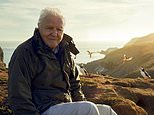
Wild Isles (BBC One)
The most celebrated sequence in the history of wildlife documentary making shows Sir David Attenborough chatting to camera as a family of gorillas clambers around him.
More than 40 years later, he has recreated this famous scene from Life On Earth for his latest nature series – only this time, the 96-year-old broadcaster is stretched out on a clifftop with a colony of puffins.
Wild Isles celebrates the epic scale of his inimitable animal adventures, but for the first time confines his travels to Britain. The result is a blend of Life On Earth and The Wind In The Willows.
It has the heart-pounding drama we expect from Attenborough, combined with the gentle charm of our familiar countryside. At one extreme, there’s a hunt as merciless as anything seen on the savannah, as a pair of sea eagles chase and kill an exhausted barnacle goose in the Hebrides.
Wild Isles celebrates David Attenborough’s epic scale of his inimitable animal adventures, but for the first time confines his travels to Britain. The result is a blend of Life On Earth and The Wind In The Willows. Pictured: Attenborough now, aged 96
The most celebrated sequence in the history of wildlife documentary making shows Sir David Attenborough chatting to camera as a family of gorillas clambers around him. Pictured: Attenborough in 1979
At the other extreme, we watch a mother dormouse climb an oak tree to sup on honeysuckle nectar, while her babies peep out of the nest like cute extras in a Walt Disney animation.
Series producer Alastair Fothergill, who has worked with the veteran presenter since 1987, told me last month that the sea eagle footage was unique.
The hunt has never been captured on film before – one of the criteria for Sir David, who loves to capture and share new animal behaviour. ‘We had a budget to do the impossible,’ Fothergill said. ‘It took us 70 days to film the sea eagle behaviour. There’s hardly a county in the British Isles where we didn’t film, and then we cherry-picked the very best moments.
‘I am confident that the biggest sequences in every episode of Wild Isles would easily earn a place in any of Sir David’s global series, such as Planet Earth. We’re showing things you wouldn’t believe could occur in Britain – such as killer whales hunting seals.’
Captured off Shetland, those pictures opened and closed the first episode and they were truly spectacular, as awe-inspiring as anything filmed in the Antarctic for last year’s Frozen Planet II. Using underwater lenses, drones and a stabilised camera on a boat, the crew were able to watch a pod of killer whales, or orcas, cruising for prey.
Filmed over the course of three years in 145 locations using the very latest technology, this incredible five-part series looks at four habitats
Now that Sir David has turned his attention to home, he’s more of a national treasure than ever
One sidled up an underwater trench like a mugger prowling the backstreets on a Saturday night. It swam on its side, so its dorsal fin wouldn’t break the surface and give it away.
When the whales spotted a seal sleeping in the water, they pounced – only to switch their attack at the last moment and seize a terrified pup.
The adult seals cowered on the rocks, plainly terrified, while the killers dragged their half-dead catch out to sea and flung it around before tearing it to shreds. This bloodthirsty drama was mirrored on a smaller scale in a meadow of wildflowers, where a vixen was teaching her cubs to hunt voles.
That’s a sight once commonplace in Britain, though nowadays you’re much more likely to see a fox overturning a plastic bin of scraps, raiding the recycling on a city street.
Sir David’s voiceover warned that 97 per cent of the hay meadows that speckled the landscape when he was a boy before the Second World War have disappeared. More alarming still, 60 per cent of Britain’s insects have been wiped out in the past 20 years.
During a weekend of unprecedented PR disasters for the Beeb, it emerged that five episodes of Wild Isles will air on BBC1, while a sixth examining the decline in Britain’s natural life – called Saving Our Wild Isles and partly funded by nature charities the WWF and RSPB – will be available only via iPlayer.
The BBC has insisted it was never intended for mainstream broadcast. True or not, that is ridiculous: the whole point of an impartial public broadcaster is not to suppress viewpoints, but to air all sides of the argument.
Who better than Attenborough to argue for the preservation of the landscape? It’s up to those who disagree with his analysis to present their own case – not the job of the BBC to hide opinions on iPlayer and hope nobody notices them.
Anybody who wants to lock horns with Sir David will find him as passionate as ever about the natural world. ‘He jumped at the opportunity to go to wonderful places,’ Fothergill said. ‘He is on amazing form.’
Wild Isles is set to begin on BBC One on Sunday and will showcase the natural wonders of the UK and Ireland
He certainly had fire in his eye as he reclined on the grass of Skomer Island, off the Pembrokeshire coast, to watch the puffins a couple of feet from his face.
‘Though rich in places, Britain as a whole is one of the most nature-depleted countries in the world,’ he concluded. ‘Never has there been a more important time to invest in our own wildlife, to try and set an example to the rest of the world and restore our once wild isles for future generations.’
Now that Sir David has turned his attention to home, he’s more of a national treasure than ever.
Source link
CHECK OUT: Top Travel Destinations
READ MORE: Travel News



